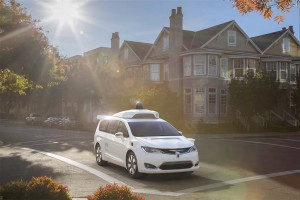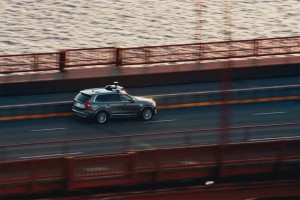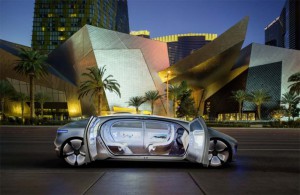Two new automotive technologies are likely to not only transform the way we get from Point A to Point B but impact virtually every aspect of our daily lives, according to a new study from computer chip giant Intel.
In the process, autonomous vehicles and ride-sharing will create a market for new goods and services likely to reach $800 million by 2035 and then climb, by 2050, to a staggering $7 trillion – more than a third the size of the American economy last year. And those figures don’t even include the actual cost of the new generation of vehicles that will dominate, perhaps even completely take over, U.S. highways.
We are heading towards a situation where “we humans become riders, instead of drivers,” said Doug Davis, an Intel vice president and co-author of the new study which looks at what the chip manufacturer is calling the “passenger economy.” While there are many unknowns, Davis says that, “At the end of the day, this presents a huge opportunity.”
Ride-sharing has already become commonplace in many parts of the country, millions of Americans at least occasionally calling for a ride using smartphone apps. Meanwhile, most major automakers, as well as a number of tech giants like Google, are working to bring fully autonomous vehicles to market. Fully hands-free models are expected to be in production by 2020, and Ford and Daimler intend to take the next step, launching completely driverless vehicles, by 2022.
(Delphi looking to get Intel inside its autonomous technology. Click Here for the story.)
Those two automakers intend to target ride-sharing services like Lyft and Uber. Travis Kalanick, CEO of Uber, has already projected that the cost of using a service like his will collapse if the driver is taken out of the equation, to the point it will become cheaper to rely on ride-sharing rather than own a personal car.
Various studies issued this year, including ones from the consultancies Boston Consulting Group and RethinkX, have projected that by 2030 anywhere from 25% to as much as 95% of the miles Americans travel by road will be done in driverless, electrified vehicles operated by ride-sharing services.
The Intel study attempts to take that topic to the next level, examining what that might mean for the country, its consumers, and for the economy.
Such vehicles “will reconfigure time and then space, to some extent, and will ultimately lead to changes in land use and services,” said Greg Lindsay, one of the survey participants and a senior fellow at the non-profit New Cities Foundation.
Much as the arrival of the mass-market Model T led to vast changes in the American landscape a century ago, the “passenger economy” is likely to see “a massive reconfiguring of the U.S. in the form of suburbia and malls,” Lindsay added.
Exactly what sort of changes are at least as difficult to product as was the impact of the first automobile – or, more recently, the arrival of the personal computer and then the smartphone, the study’s participants stressed.
There could be major population shifts. By making it easier and more affordable to get around without having to have a home with a garage, that could encourage more people to return to cities. On the other hand, autonomous vehicles are expected to make roads safer and flow more smoothly. And, since passengers would be able to nap, play, dine or work without having to actually drive, this might encourage more people to move even further out into exurbs and rural areas.
“we could see a situation where people are (quite) willing to commute several hours a day,” said Lindsay, during an Intel conference call, and not just suffer through the experience.
The study’s authors also noted that transportation should become more “democratized.” For those who currently live in inner cities with limited access to either an automobile or mass transit, this should make it easier and more affordable to travel and get to where good-paying jobs are located.
Beyond changing where we might live and work, the passenger economy is expected to give rise to a concept called “mobility-as-a-service,” Intel predicts. Today, you can use your smartphone to access a ride on Uber and choose between a cheap, car-pool-like experience, a mainstream vehicle, an SUV or even a limo. In the years ahead, ride-sharing services might offer all manner of mobile alternatives as they “bring services to you,” said Lindsay.
(Click Here for more details about Intel’s push into the automotive market.)
Imagine having a car pull up at the end of the workday with a hot meal waiting, or your shopping all done and waiting in the trunk, perhaps even a stylist to give you a haircut or a manicure and pedicure on the way home.
The $7 trillion figure forecast for mobility services in 2050 breaks down into
- $3.7 trillion, or 55%, for consumer services;
- $3 trillion, or 43%, for business-to-business services, such as office supply deliveries; and
- $203 billion for other new vehicle-related services and features.
One of the big questions is who will benefit from the emergence of the passenger economy? Today, carmakers are focused on selling sheet metal, and traditional manufacturers – such as Ford, Toyota and Volkswagen — likely will continue to produce a major share of the cars on the road. But how many cars will be needed is unclear. Recently ousted Ford CEO Mark Fields, a proponent of the passenger economy, said he expects sales could drop sharply over the next 10 to 15 years as ride-sharing catches on.
To make up for lost revenue, the Intel report said, “Carmakers may ultimately vie (with services like Lyft and Uber) to operate particular networks of vehicles for particular cities.” And they will focus more on generating service business than manufacturing and car sales.
(To see why investors betting big on autonomous technology, Click Here.)
But new players, including up-start carmakers like Tesla, tech firms like Google’s autonomous spin-off Waymo, and ride-sharing firms like Uber and Lyft, all will be seeking to dominate, or at least grab a piece of this huge new economic pie.




It will be interesting to see how this plays out in places like small-town Georgia, the state with the most miles of paved roads in the US, often with no edge markings. As automation and AI take away most manufacturing jobs, and the cost of traveling locally plummets, what sorts of changes to services will occur and how will the fact that what we call low-wage jobs will be most of the economy then change things? Will the wealthy drive? On dedicated roads!